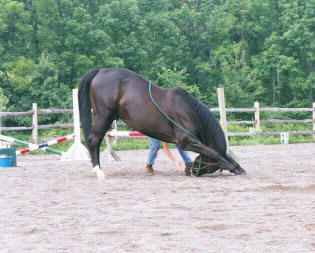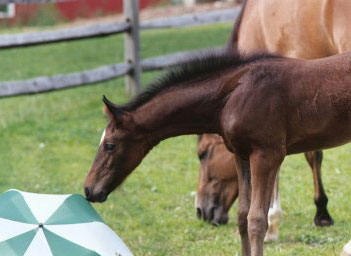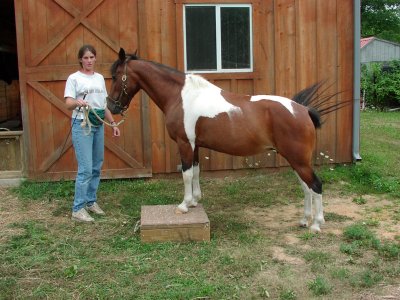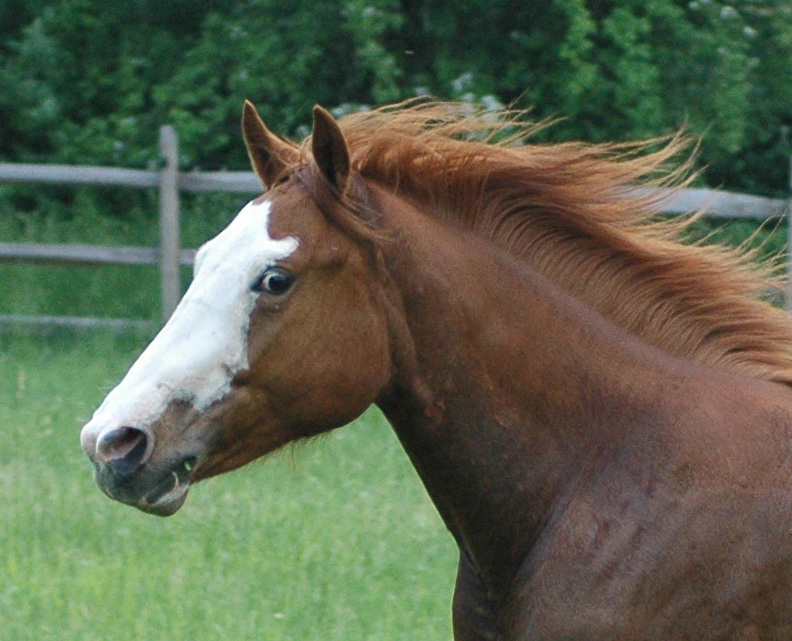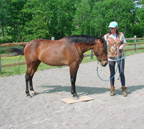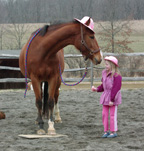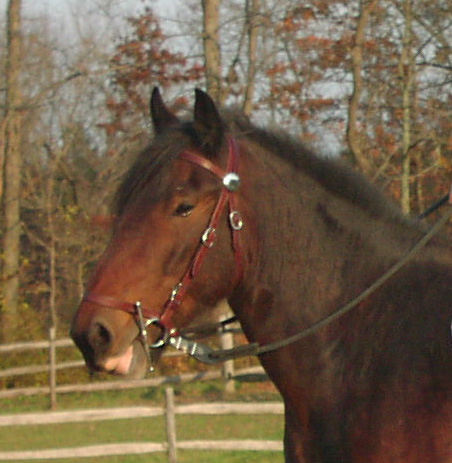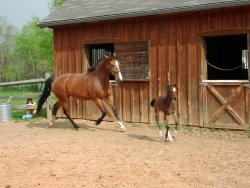|
Getting Started With Riding: Common Questions
This is a follow up to the article "Getting Started Riding: Handling
and Delivering Food." If you are new to the idea of using clicker
training under saddle, I suggest you read that article before this
one. This article answers the next set of questions which are more
to do with the actual training itself.
This is still all basic information answering some common
questions about clicking under saddle.
The questions I am
going to cover are:
What do I want the horse to do when you click?
How do I want the horse to stop when I click? And what do I do if he
stops abruptly?
What do I want the horse to do after I feed him?
How do I get anything done with all the stopping?
How do I decide what to click during a session?
How do I handle stimulus control?
Can I still ride with teachers and trainers who don’t allow
clicking?
I did some mental hemming and hawing about how in depth to go into
some of these questions. There is a simple and safe answer for each
of them. But in the
end, I decided to go into more detail because I find it is helpful
to have a larger picture of how things can be done.
One of my favorite riding instructors always teaches an
exercise and then explains what can be done with it in the future,
so that I have a sense of the progression as my horse and I become
more advanced. I like this because even if I am not ready for those
steps yet, it helps me to know they are out there so I don’t get
stuck on the most basic version of the exercise.
Using clicker training under saddle can be done on many levels and
as I get more experienced at it, I find that I appreciate and use a
lot of different strategies at different times.
So as you read the answers, think about what you might want
to do now, but also keep in the back of your mind that as you and
your horse develop as a team, some other options might become useful
too.
What do I want the horse to
do when I click?
My horses are all trained to stop when I click.
This works great for any behavior when I am on the ground and
is essential if I am using food reinforcer, because the horse has to
stop so I can give him his food.
Under saddle, I start off with the same rule which is that
when I click, I would like the horse to stop in a timely manner.
A timely manner does not mean the horse has to slam on the
brakes. It just means that the click should be a cue to start
stopping.
I find that most horses figure out very quickly that when I click, I
want them to stop. If
the horse doesn’t, then I just nicely ask the horse to halt.
I’ve met a number of traditionally trained horses that had to
be taught to stop for the click.
I think in many cases, these horses had been taught that
stopping (without the rider actively asking for it) was not allowed,
so they don’t realize that I want them to stop when I click.
Sometimes this just shows up
at the faster gaits so they will stop from a walk, but not a trot or
canter. If given
a little more time and some reminders, they usually figure it out.
Doing some groundwork at the trot or lunging, and clicking
during movement, can
sometimes bridge the transition between groundwork and riding if a
horse seem unsure what to do when I click.
What do I want the horse to
do after I feed him?
In the previous article, I wrote about how to teach the horse how to
get his food, but I didn’t say anything about what I want the horse
to do after he gets his treat.
It’s something that is worth thinking about because once I am
mounted, I have additional choices.
It’s also one I should think about so that I can be
consistent. Here are
some options:
·
I can teach him
to stand still until I cue him to do something else.
This is the “safest” option and the one I use with green
horses or horses that are just starting clicker training under
saddle. I will feed the
treat, wait until he is done chewing, and then cue him to go
forward. I make sure to give
the horse the time he needs to eat his treat. I have some horses
that are happy to finish chewing while we get started again. I have
others that want to be completely done chewing before they go.
It’s important that I am clear about my go forward cue so
the horse doesn’t anticipate as I start to gather the reins, etc…
·
I can permit
him to walk off while he is chewing his treat and let him walk on a
loose rein until I cue something else.
I like this option for my
more experienced horses when they are working at home.
If I ask them to stop and stand while they are chewing every
time I click, they end up spending a lot of time standing around.
I would rather let them walk
as part of their reinforcement.
When I’m ready to go, I gather the reins and we start again.
For some horses, being allowed to walk on a loose rein adds to the
quality of the reinforcement as they get a chance to stretch, look
around, etc… This is
especially true if the horse is feeling a little anxious and would
rather walk than halt.
It may seem safer to have the horse stand still while he is chewing,
but I find that being allowed to walk and eat is often a great way
to give the horse a little mental break and allow him to move
without being directed.
It’s a little bit of a judgment call as to whether this is safe or
not, so you do have to know your horse and how he will behave if
given a loose rein when he’s nervous.
I should also point out
that if the horse won’t stand still to eat the treat, you should
probably be asking why.
My horse, Rosie, is often nervous in new locations and when I first
get on, she doesn’t want to stand still after getting her treat.
But after a few minutes she settles down.
Because I know that this
behavior is typical for her and that she will improve as she gets
more relaxed, I will allow her to walk off in the beginning of a
ride in a new place.
She is very comfortable walking on a long rein, even in a new place,
so this is a safe behavior to let her do.
·
I can let the
horse tell me when he is done eating and ready to go again. .
I find this happens naturally when I am shaping behavior with
a high rate of reinforcement and the behavior is not yet on cue.
I will click, treat and my horse will offer the behavior
again when he’s ready. I
usually only do this if I am working at the halt or at the walk.
I’ve also played around with it a little bit intentionally
where I have chosen a behavior that the horse can offer and I think
there are some interesting possibilities for allowing the horse to
cue me that he is ready to start, as opposed to me telling him when
you are starting again.
I think it’s important to
be consistent about what you expect your horse to do, but that
doesn’t mean you have to always do it the same way.
You can have cues that tell the horse if walking off is
permitted or not. With
Rosie, if I click and treat while releasing the reins down to the
buckle, then she has the choice of standing still or walking off.
If I don’t want her to walk off, then I click and treat while
keeping the reins shorter and she will stand still.
We have worked out a system so she knows what to do and
that’s what makes it possible for me to use both options.
How do I want the horse to stop when I click? And what do I do if he
stops abruptly?
I like my horses to come to a balanced halt when I click.
One thing to remember is that the behavior sequence from
click to halt is going to be practiced many, many times, so it’s
worth putting some thought and time into making it smooth.
Note that I said “smooth,” not perfect.
You just need to find something that is comfortable for you
and your horse at his level of training and that suits your interest
(discipline) or riding style.
In some cases, coming to a smooth stop will not be an issue and the
horse will stop nicely for the click from the very beginning.
I find that many horses that have had previous training
before they are introduced to clicker training will stop in a
comfortable manner. They have already had lots of practice with down
transitions so they know how to do one and the click just becomes
another cue to stop. My older horse, who had been ridden
traditionally for years, halted just fine when I clicked and I never
had to spend any time working on it.
But other horses will either stop very abruptly or stop out of
balance. In the long
run, I want my horse to stop easily from any gait in a nice balance,
but until we get there, I do want to have alternatives so that the
horse does not practice stopping abruptly, which is probably not
good for either of us from a physical point of view.
I am listing these as “workarounds” so I can avoid clicking
while the horse is trotting or cantering, but all of them are also
useful for other reasons, and even after my horse can stop nicely
from any gait, I may continue to use them when I am working on more
advanced exercises.
Some of them will also help teach the horse to stop in better
balance so I am working toward my long term goal at the same time.
Here they are:
·
I can work in
short chains. Chaining
is when I ask for several behaviors before clicking.
If you don’t know anything
about chains, I suggest you do some additional reading on them.
There is some information on chains in the Clicker Expo 2008
Report on my website and also in the article on Loopy Training.
I wrote an extensive series on chains, which is on my
facebook page (Sept 2014). Chaining
behaviors together allows me to ask for several behaviors and only
click the last one. For
example, if I am working on improving my horse’s trot, but he tends
to stop abruptly when I click the trot, I could set up a simple
chain of walk -> trot -> walk -> click -> treat.
This is a great strategy to use when a horse is just learning to be
ridden in a new gait and I want to work on transitions into and out
of it. I start by
clicking for the up transition until the horse has the general idea
of what I want.
It doesn’t have to be perfect, but I like to see some understanding
of what behavior I want.
Then I will click for the down transition.
At this point I am not asking for a lot of duration. I just
want the horse to practice the transition into and out of the new
gait. By clicking the
down transition, I have built a short chain of walk -> trot-> walk
-> click -> treat.
Some horses initially find this confusing and I may lose the
up transition, so I go back and click for trot a few more times, and
then go back to the chain.
Once horses understand chaining, it’s an easy strategy to use
for adding in new behaviors where clicking during the behavior might
be counterproductive.
Once the horse understands the short chain of walk -> trot-> walk, I
can add more transitions or other behaviors to it so that the horse
does more and more behavior before it gets clicked. If the last
behavior in the chain is a walk or halt, then I can still practice
working at faster gaits without clicking during them.
In addition to being a
workaround for clicking at the trot and canter, chains are a great
way to teach horses to go for longer periods before getting clicked
and also to practice transitions into and out of behaviors.
I want to add a note that,
in theory, the cue for a positively trained behavior acts as a
reinforcer for the previous behavior in a chain.
That would suggest that behaviors in a chain will be
maintained just by being used in chains, but I don’t find this to be
true. Every behavior in
a chain also needs to be practiced and reinforced on its own at
times. This works
out because if you do enough chains with transitions, your horse’s
transitions will improve and you will be able to choose to click
within the gait at times. So
while you may start off using chains so you can avoid clicking at
trot and canter, the use of chains to practice transitions will make
it so that you can click at the trot or canter if you wish.
·
I can have
another marker that does not mean “stop now.”
The click in clicker training is a marker signal that is used
to identify the behavior I want to reinforce, but markers also
function as cues because the horse learns that it should do
something specific when it hears the marker.
With the click, most horses are taught to stop to get a food
treat. With dogs, the click often means to check in with the handler
to see where the food will be delivered (hand fed, thrown, put in a
bowl, etc…).
But the click is not the only marker you can use.
Horses can learn to recognize lots of different maker signals
and it’s easy to condition one that is associated with food (or a
different reinforcer), but that doesn’t cue the horse to stop.
This marker would still have the function of marking the
correct behavior, but the horse would accept input from the rider
about what to do after he hears it.
If I want to condition a
marker (secondary reinforcer) that does not mean stop, I just need
to change what I ask the horse to do after I mark the behavior. If I
want the horse to keep going, then I will mark and encourage some
forward movement (maybe walking a few steps before I ask it to stop
and feed it). Or
I could mark and walk the horse to a bucket or a designated feeding
station to get his treat.
If I choose a consistent delivery pattern of walking a few
steps before I feed or going to a specific location, the horse will
that food is coming but that he doesn’t have to stop right away.
I can even introduce several
options, if I am careful and systematic about it, so that the horse
learns to check in with me to find out what to do after I mark a
behavior. It IS
important to be systematic about teaching the horse what he might
need to do so that he doesn’t get confused but I have found that
horses are pretty good at reading body language to see where the
treat will be delivered once they know all the options.
Even so, it’s a good idea to try to be consistent within a
session so the horse doesn’t have to figure it out every time I mark
a behavior.
So additional markers can be useful, but I have to say that I like
the clarity that comes with only using the click to indicate that
food is coming. When I
use other markers, I prefer to pair them with other reinforcers
instead of with food.
This can be done by conditioning secondary reinforcers (see my 2008
and 2009 Clicker Expo articles on them) and works well as long as I
am sure to maintain their value.
Another alternative is to condition what would be considered a
“tertiary reinforcer,” which is a marker that precedes the click.
That means that I use my marker, ask the horse to stop, click
and then treat. In this
case, there are really two markers.
The first marker takes on the job of identifying the behavior
I am reinforcing. The
second marker (the click) happens when I halt so it probably does
mark that behavior, but it functions more as a cue to turn and get
the treat. Since I
usually click after the horse has halted, this works out ok for me,
but I do think you have to be careful when you are using multiple
markers In general, I find
that the more complicated you make this, the more complicated it
becomes to tell if your marker is still meaningful so you have to be
observant about whether or not the horse is using the marker as
information.
The idea of using a variety of markers is something that I am
currently exploring, prompted by some work in Kay Laurence’s TAKL
course so I’ll write more about this later. I find that horses are
very quick to pick up on new markers and the challenge is more about
keeping everything straight so that all markers don’t end up meaning
the same thing and I don’t end up with unwanted markers.
·
I can teach the
horse to “downshift. “
Downshifting means that instead of going from canter to halt when
clicked at the canter, the horse goes canter -> trot -> walk ->
halt. I debated
about whether or not to include this because it does mean the click
stops meaning “stop right now” which some people like.
The difference is that in a horse that has been taught to
downshift, I have the option of clicking and allowing the horse to
stop (I do nothing) or clicking and riding the horse down to the
halt (I have some control over how he gets there).
The horse still knows he is stopping, so the click is still
associated with stopping, but it does not mean “stop right now.”
Some people do want the horse to stop on a dime when they
click so if that’s your preference, then I would not teach this.
However, I find it very useful for certain stages of training
where I want to mark within a faster gait, but the horse does not
yet know how to do a halt transition out of the gait.
I’ve also found that even
doing a little bit of this on the ground can “soften” a horse’s halt
so that it’s not so abrupt.
The easiest way to teach a horse to downshift is from the ground. I
start by clicking at the walk and having the horse step forward to
get his treat. So he
learns that the click does not mean “glue your feet to the ground.”
Then I do the same thing at the trot. I click while the horse
is trotting, he stops and I have him walk forward a step or two to
get his treat. In the beginning, it’s fine if he stops on the click
and then walks forward. After enough repetitions, he’ll start to get
the idea. I find it helps if I click and walk to where I want him to
be, instead of walking to him and then asking him to go forward.
It’s a bit like the idea of using a bucket and having the
horse walk forward to the bucket as I go to it and drop the treat
in.
I practice this during
in-hand work, groundwork or lunging.
When lunging, I teach my horses to wait on the circle until I
bring them their treat. So it’s easy for me to just walk a few feet
in front of their head and have the horse come forward to me.
After we do this a few times, instead of walking to the horse
and going forward together, they will anticipate and step forward to
where we will meet on the edge of the circle. They also learn to
read my body language to see where I will be presenting the treat.
You can play around with this and even add a cue that
indicates if you want them to wait and you will bring the food to
them where they are, or if you want to meet them farther along on
the circle.
Once a horse learns to downshift, it doesn’t mean they always have
to downshift. Rosie has
learned to read my seat and aids to see if she should downshift or
can stop right now. In
her case, her natural tendency is to stop when I click because
that’s what she learned first.
If I click and don’t change what I am doing, she will stop.
If I click, keep riding with my seat and/or close my legs a bit,
then she will keep going and downshift as soon as I relax a bit or
when I cue the down transition. She
knows the down transition is coming, she just waits so we do it
together.
I can’t say that this process works perfectly. Some days we are more
connected than others, but we have gotten better over time and think
that it has actually helped her to be more responsive to my seat.
I find it helps if I am
consistent within an exercise. So if I am working on counter-canter
and want her to downshift, I will ask her to downshift on every
click while I am working on counter-canter.
I can then continue to ask her to downshift on other
exercises, or I can go back to clicking and stopping. I just don’t
mix them up randomly as I think that would get too confusing.
·
I can work on
the transitions themselves. This
is not really a “workaround” and I already mentioned it in the other
sections, but I wanted to list it separately too because it’s
important. If I want my horse to come to a balanced halt from the
trot, when I click, I need to teach him how to do that.
The abrupt and unbalanced
stopping that can happen when I click is often a combination of the
horse wanting to stop quickly and not knowing how to do it. It’s not
that easy to do a balanced halt and most horses will just slam on
the brakes. I used to joke that Rosie would just stop moving her
feet when I clicked so she would land in a heap because the click
meant “stop moving your legs” not “come to a stop.” She does take
things literally…
How do I decide what to
click during a session?
I am going to give a very general answer to this because it depends
upon how much shaping I do on the ground vs. under saddle and when I
add cues. When I
am riding, I often have many behaviors in many different stages of
training and this will affect how I structure my session and what I
am clicking. So I could be
working on different things for different behaviors, or working on
similar criteria for several behaviors.
Here are some examples:
·
If I am shaping
a behavior, then I will have my horse on a fairly high rate of
reinforcement and I will be clicking for specific criteria within
that session. In the case
of ridden work, I consider a session to be a small segment of
training within the larger ride.
So if I am teaching my horse to back, I might spend 5 minutes
working on backing and only backing.
I will choose one aspect of backing (straightness, duration,
topography, etc…) and work on that for that session.
I can repeat the session again later in the ride or just do
the one session and pick up again on the next ride, either with the
same criteria or with a new set of criteria.
·
I could be
working on stimulus control and my horse’s response to cues.
In that case, I would be
riding around and clicking for a lot of different behaviors.
I might click more for
correct answers to newer cues or for the horse discriminating
between two similar cues.
·
I could be
working on making small improvements in already trained behaviors,
or selecting out better variations.
In my warm-up, I might be clicking for good transitions,
duration, or responding correctly to cues within a behavior (slower
trot, more bend etc…).
When I am doing this, I don’t consider that I am actively shaping
these behaviors, but I am still aware that some are better than
others and will click for ones of better quality.
It may look as if I am
clicking and treating at random, but I usually have a pretty good
idea what kind of reinforcement each behavior needs and where I am
looking for improvement.
·
I could choose
the same criteria and apply it to several different behaviors. Many
of the behaviors I train have some of the same criteria and I
sometimes find it helpful to work on several behaviors with the same
criteria in mind. So if my horse tends to be a bit slow or sluggish,
I can click for adding energy to walk, trot and canter.
Or if he’s too quick, I can
do the reverse. Often
it will be easier at one gait and that will help the others.
I can also do this with criteria like latency, relaxation,
straightness, bend, suspension, collection etc…
I find that it helps horses to generalize and this is helpful
to teach about riding aids and being more connected to the rider.
The horse starts to understand that when I sit like this, it
always means the same thing and then I can use it in new situations.
How do I get anything done
with all the stopping?
In the beginning, especially on a green horse, all the stopping is a
good thing. It
gives me lots of opportunities to think about what is happening,
gives the horse a moment to think and rebalance and provides lots of
opportunities to start and stop behaviors.
Transitions out of the halt give the horse lots of chances to
practice going again. Transitions
are also valuable from a physical point of view as doing a balanced
walk -> trot transition is often harder that just trotting five more
steps. Dressage
trainers consider transitions to be excellent for conditioning and
teaching a horse to use his hind end well.
I also like to have the
horse on a pretty high rate of reinforcement so that they are
getting a lot of feedback, which builds their confidence, and keeps
him motivated and engaged in the session.
But at some point, it is a good idea to start working on duration
and building chains.
This will extend the time between clicks and allow me to practice
going from one behavior to another.
In the question “How do I want my horse to stop?” I wrote
about using chains so that I didn’t have to click at the faster
gaits. Chains or patterned exercises are also useful for teaching a
horse that it might be asked to do multiple behaviors before it is
clicked. I start to
introduce chains gradually and then slowly add more duration for the
behaviors within the chains.
I find that it’s easy to build chains that build up to the clickable
behavior. For
example, If I want to work on a behavior at the trot, my horse has
to go from halt-> walk -> trot before I can even ask for the
behavior I want, so he gets to practice all those behaviors as part
of working on the trot behavior.
This is related to the idea of having a sense of purpose
which I wrote about on my facebook page in March 2015.
If the horse knows what behavior is going to be clicked and
you can set it up so that he has to do other behaviors to get there,
he will be motivated to keep going even if it takes longer to get to
the click and reinforcement.
How do I handle stimulus
control?
I train most behaviors on the ground first and then finish them
while riding. This means that most of the time I already have the
behavior on cue before I ask for it from the saddle.
If the same cue will work from the saddle, then I don’t have
to change the cue. If the cue is not practical to use from the
saddle, then I can add a new cue. Adding
a new cue can be done by preceding the old cue with the new cue. The
horse will eventually anticipate and I can then switch to using the
new cue. That’s a VERY
short explanation of how to do it. If you want to learn more about
adding cues, there are
some good resources out there (Alexandra Kurland’s DVD on stimulus
control, Kathy Sdao, etc.c..) In
either case, most of my ridden behaviors have some kind of cue from
quite early on so this means I start out with some level of stimulus
control.
But…since the behavior is often not “finished” at this point and I
continue shaping while riding, I am somewhat flexible about how
tight I keep my stimulus control for each behavior.
In general, once a behavior is on cue, I want the horse to do
the behavior when I ask.
So when I say I have looser stimulus control, what I mean is
that sometimes I will allow and even reinforce behavior that is
offered before I cue it. It
does not mean that I accept a lot of uncued behavior or that I want
my horse throwing behavior at me. And
sometimes I will accept an unexpected answer if it opens up new
possibilities for training.
This happens mostly if am doing a shaping session on a specific
behavior within my riding session.
Remember that in shaping I can relax some criteria when I
work on a improving a specific aspect (a different set of criteria)
for a behavior.
Stimulus control is just another aspect of behavior and can be
adjusted as needed, as long as I take into consideration safety, the
type of behavior being offered, my horse’s understanding of stimulus
control, and my relationship and experience with the horse.
What I have found is that as my relationship with my horse and our
understanding of riding together improves, it’s important to make
sure that we continue to have a two-way conversation. If I get too
rigid about stimulus control, then the conversation becomes a bit
too one-sided. I
think this may be one difference between horse training and some
other types of animal training. When I train my dog, I will set
aside a small time block (maybe 10 minutes) and work in short
sessions within that block (1-2 minutes) with some breaks in
between. These tend to be very focused sessions and I am careful
about maintaining my stimulus control unless I am shaping a new
behavior, in which case I have often not added the final cue
stimulus control is less of an issue.
But with horses, my sessions are much longer (maybe two hours) if I
include bringing the horse in, grooming, tacking her up, riding, and
all the after-ride stuff .
So I have parts of that time where we are more casual and I
am want the horse to have some freedom to interact with me in
acceptable ways and parts of that time when I am doing more focused
work. This means that during
that training time, my stimulus control is slightly more fluid than
it would be if I only worked with the animal for “x” minutes of
dedicated training time.
I’d like to add that it’s
always important to make sure that any changes in stimulus control
or allowing offered behavior don’t make my horse frustrated or
confused. I find that
my horses are really quick to pick up on patterns of how I train
behaviors if I am consistent about the general progression.
If they seem to get confused, then I have not been clear
enough about what we are working on and I need to go back and
clarify.
Can I still ride with
teachers and trainers who don’t allow clicking?
It depends. I hate to give that answer but it really does depend
upon your horse’s previous training experience, your own skill level
in clicker training and riding, and on the person who will be
teaching you. There are
some crossover horses who seem to go back and forth between clicker
and non-clicker sessions quite easily, especially if they are done
in different locations (clicker at home, non-clicker away at
lessons, shows, etc…).
My first clicker horse had been ridden traditionally until he was 15
and I could ride him with or without clicker training.
He was much better if I did use clicker training, but he
still remembered all his previous training and I could ride him in
situations where I could not click and treat.
At some point I’ll write a longer article about riding with
non-clicker trainers, but for now here are a few tips:
·
Clicker
training is not just about the click and treat. It’s a training
philosophy that emphasizes breaking behavior down into small steps
and reinforcing the horse for correct answers.
Clicker training is also about recognizing that horses are
smart animals who are doing their best to figure out what we want.
If you choose a trainer that has this same attitude toward
horses and understands how to break behavior down into smaller
pieces, you are more likely to be successful.
I have had good results working with some very traditional
trainers whose teaching style is very compatible with clicker
training just because of how they teach behaviors and structure
their lessons.
·
Some trainers
are very opposed to using food in training, but others are ok with
feeding a treat for a job done well.
Working with a trainer who does allow the use of food (even
if they are not a clicker trainer) means you can still provide some
of your horse’s usual reinforcement.
You can use a tongue click or alternate bridge, or just
reinforce the horse for behaviors he knows well where the marker is
less important.
·
Think ahead of
time about what you want to get out of the lesson and prepare your
horse. Depending upon your skill level and what you want to teach
your horse, this may be easy to do, or not… But I find it’s always
possible to do some preparation that will make things go more
smoothly. If I want
help with a specific exercise, I often teach my horse as much as I
can before the lesson and just use the lesson to get additional
pointers and feedback from some “eyes on the ground.”
It means that I am not teaching something entirely new in the
lesson so my horse is more likely to be successful even if I can’t
click and treat.
·
Be your horse’s
advocate. If you get in
a situation where you are uncomfortable with what the trainer wants
you to do, it’s important to say so.
For me, this would be a red flag that this person might not
be a good match, but I have sometimes found that it is possible to
have a discussion about alternate ways to do things.
This can actually be a good opportunity to learn more about
the teacher’s philosophy and also share your own views on training.
Then you can decide if continuing to work with that trainer
is a good idea or not.
I’m going to add to this article as I have time.
If you have general
questions that are about using clicker training under saddle, you
can email them to me and I’ll be happy to answer them.
If you have any additional
information on these topics that you think might be helpful, I’d
love to hear it. I am always open to ideas about other ways to do
things and what works for me might not work for everyone else so I
like to give people a variety of options.
Happy clicking!
Katie
Questions, comments, thoughts? you can email me at
kabart315@gmail.com
Katherine Bartlett, copyright 2015. If you would like to share this
article, please share the link to the entire article. If you would like to share
or copy part of this article, please email me for permission.
Back to Articles
|
